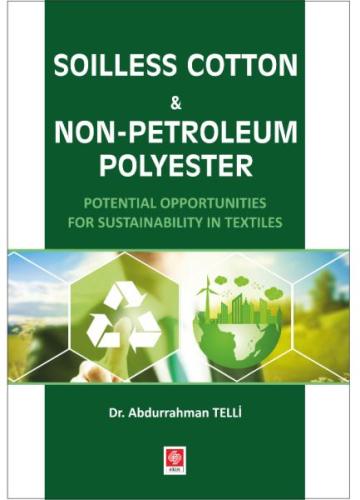9786053279280
410863

https://www.tdedkitap.com/soilless-cotton-non-petroleum-polyester
Soilless Cotton Non-Petroleum Polyester
46.40
1. INTRODUCTION
2. SUSTAINABLE PRODUCTION
2.1 Economic Responsibilities:
2.2 Social Responsibilities:
2.3 Environmental Responsibilities:
3. SUSTAINABLE TEXTILES
3.1 Minimization of direct impacts on people:
3.2 Less harmful production to the environment:
3.3 Maximum utilization from recycling:
4. SOILLESS COTTON
4.1 The limitations of soilless cotton:
5. NON-PETROLEUM POLYESTER
6. THE COMBINATION OF SOILLESS COTTON AND NON-PETROLEUM POLYESTER
7. GREENWASH AND ECO- LABELLING
8. SUGGESTIONS
8.1 Suggestions for Producers
8.2 Suggestions for Consumers
9. CONCLUSION
2. SUSTAINABLE PRODUCTION
2.1 Economic Responsibilities:
2.2 Social Responsibilities:
2.3 Environmental Responsibilities:
3. SUSTAINABLE TEXTILES
3.1 Minimization of direct impacts on people:
3.2 Less harmful production to the environment:
3.3 Maximum utilization from recycling:
4. SOILLESS COTTON
4.1 The limitations of soilless cotton:
5. NON-PETROLEUM POLYESTER
6. THE COMBINATION OF SOILLESS COTTON AND NON-PETROLEUM POLYESTER
7. GREENWASH AND ECO- LABELLING
8. SUGGESTIONS
8.1 Suggestions for Producers
8.2 Suggestions for Consumers
9. CONCLUSION
1. INTRODUCTION
2. SUSTAINABLE PRODUCTION
2.1 Economic Responsibilities:
2.2 Social Responsibilities:
2.3 Environmental Responsibilities:
3. SUSTAINABLE TEXTILES
3.1 Minimization of direct impacts on people:
3.2 Less harmful production to the environment:
3.3 Maximum utilization from recycling:
4. SOILLESS COTTON
4.1 The limitations of soilless cotton:
5. NON-PETROLEUM POLYESTER
6. THE COMBINATION OF SOILLESS COTTON AND NON-PETROLEUM POLYESTER
7. GREENWASH AND ECO- LABELLING
8. SUGGESTIONS
8.1 Suggestions for Producers
8.2 Suggestions for Consumers
9. CONCLUSION
2. SUSTAINABLE PRODUCTION
2.1 Economic Responsibilities:
2.2 Social Responsibilities:
2.3 Environmental Responsibilities:
3. SUSTAINABLE TEXTILES
3.1 Minimization of direct impacts on people:
3.2 Less harmful production to the environment:
3.3 Maximum utilization from recycling:
4. SOILLESS COTTON
4.1 The limitations of soilless cotton:
5. NON-PETROLEUM POLYESTER
6. THE COMBINATION OF SOILLESS COTTON AND NON-PETROLEUM POLYESTER
7. GREENWASH AND ECO- LABELLING
8. SUGGESTIONS
8.1 Suggestions for Producers
8.2 Suggestions for Consumers
9. CONCLUSION
Yorum yaz
Bu kitabı henüz kimse eleştirmemiş.











